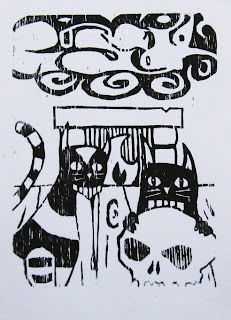 Today's Class- The topic for today was rhythm as a visual element. I showed slides of art from the Renaissance to the present that displayed a variety of rhythmic qualities. Then I played various types of instrumental music, while the students made abstract watercolor paintings based on the music being listened to, such as in the example above. In addition, we reviewed the results of the research papers, with each student reporting on some of what they learned about their art historical period, and the graded papers were returned.
Today's Class- The topic for today was rhythm as a visual element. I showed slides of art from the Renaissance to the present that displayed a variety of rhythmic qualities. Then I played various types of instrumental music, while the students made abstract watercolor paintings based on the music being listened to, such as in the example above. In addition, we reviewed the results of the research papers, with each student reporting on some of what they learned about their art historical period, and the graded papers were returned.How to make this up- Full details as to how to complete today's assignment, along with several more student examples, can be found here. It lists 5 types of music, out of which your should pick 4 to do for yourself. This is a portfolio exercise, so must be made up by the end of the semester to receive full credit.
Homework- The photography assignment given last week is due at the beginning of class next week, November 3, 2010. Have prints labeled and in order. Those who still owe me a research paper should turn it in as soon as possible to receive some partial credit for the assignment.
For next class 11/3/10- We will begin a printmaking related project, something called a collagraph. I will have materials for everyone to use, but students are encouraged to bring in a variety of natural and manufactured items with interesting textures, stuff that you don't mind cutting up and gluing to a surface. Also bring scissors and glue (something stronger than a glue stick). You don't need your 18" x 24" pad for next week.














